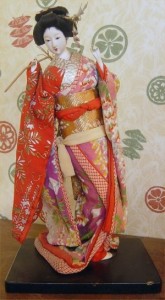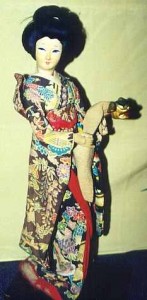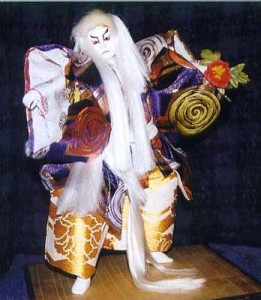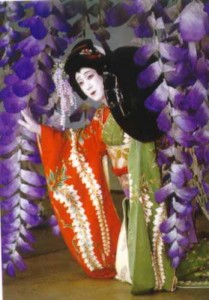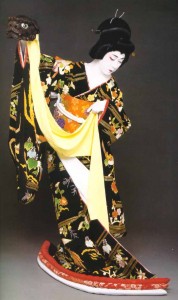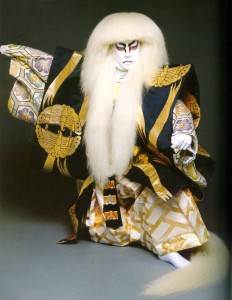This page is to help answer the question, “what does this doll represent”? It does not cover every doll, because many were made by individual artists.
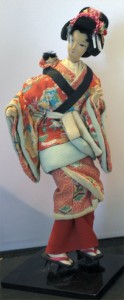
Public women:
- Geisha
- The “talented person” who provides entertainment and a companion for men in public places. A woman in a mostly dark kimono, often with a samisen (square banjo-like instrument) or hand-drum. Her pose is often exaggeratedly elegant, leaning backwards.
- Maiko
- A geisha in training, usually depicted in street wear. A girl with an elaborate, long-sleeved, brightly colored kimono (furisode), flowers in her hair, and usually wears geta (shoes) and carries a parasol. She may have bells attached to her sleeves.
- Oiran
- A top-rated courtesan of the bordello districts which were abolished in the 1950s, usually depicted based on 18th- or 19th-century woodblocks. A woman usually dressed to go out, with an extremely elaborate hairstyle with many radiating hairpins and combs, and a rich brocade coat over a red under-kimono. She wears very high geta (shoes), which in real life would make her a foot or so taller. She does not carry a parasol–because she would have a servant to carry it for her!
These three figures are discussed on the Onnagata and Oiran page, with illustrations.
Private women:
- Bride
- The traditional Japanese bride wears two outfits: at first, a colored layer suitable for a young girl, then, as part of the process of becoming a wife, a white robe signifying that she is dead to her own family and has become a member of her husband’s family. The uchikake or wedding kimono is very elaborately embroidered and decorated; it is an unbelted coat, with padded trailing edges. A bride doll wears the uchikake and often a head-dress which covers most of her hair; this is said to keep the horns of jealousy from growing, or at least from showing. She carries a fan.
- Young woman, Musume
- An unmarried young woman wears a kimono with long sleeves (furisode), usually in a bright color. Her hair is “up” but not usually very elaborate.
- Nanny or baby-sitter
- A very young girl, usually with her hair down, dressed in a warm padded coat and modest geta sandals, carrying a child on her back and often with a toy in her hand to amuse the child.
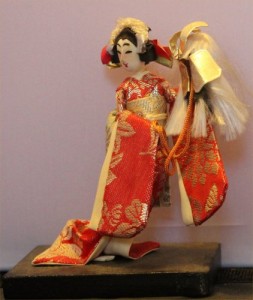
Dance or theater roles:
- Girl with buckets, Shiokumi
- See this page on her iconography.
- Young woman with lion puppet: Kagami Jishi
- A servant at the Shogun’s palace is performing a dance with the lion puppet. As she handles it, she herself transforms into a lion.
- Male “lion” figure: Kagami Jishi or Ren Jishi
- A single figure with heavy red eye-makeup and a huge white wig (like a mane) in elaborate stiff clothing, holding a peony, represents the lion into which the dancer changes in Kagami Jishi. Two lion figures, one with white hair and one with red hair, are from the play Ren Jishi, in which a father lion trains his cub. The lions derive from the Noh play Shakkyo, in which a young man has a vision of a divine lion playing among the peonies, and the Kabuki lion costume echoes the stiff, voluminous Noh costumes.
- Woman with helmet: Yaegaki-Hime
- A princess (hime) with a silvery crown in her hair. She holds a horned helmet with a tuft of long white hair trailing from it; foxes may also figure in the design in some way. This is the heroine of the play Honcho Nijushiko, set in the 15th century. She carries the precious helmet across a frozen lake, with the help of spirit-foxes, to rescue it and also her lover.
- Young woman with many flat red hats: Musume Dojoji
- A young girl falls in love with a priest of the Dojo temple, but he resists her charms and hides under a bell; she, however, is so enraged that she turns into a demonic serpent whose breath melts the bell and burns up her lover. As the play opens, some years have passed, and the temple has a new bell. A young girl comes to the temple and the priests agree to let her dance in honor of the bell. As she whirls in a dance with hats, they become scales and she reveals herself as the demonic serpent-woman!
- Young woman with a branch of wisteria: Fuji Musume
- The “Wisteria Maiden” dance has several formats, but always involves a young woman in love who represents the spirit of the wisteria flower. The doll’s dress usually is also patterned with wisteria flowers.
- Spring Horse Dancer
- A woman with a striped scarf on her head holds a horse puppet on one hand. The white horse (said to be the offspring of a mare and a a dragon) is an especially potent symbol of power and fertility. Little boys are also depicted with hobbyhorses or toy horses, but these are usually in Gosho doll format.
The first two of the three dolls below appear to represent women; they show the role, rather than the onnagata or (male) actor playing the woman. The third doll, the Kagami Jishi lion, has a more masculine appearance and stage makeup to cue the viewer to understand that it represents an actor playing a lion. For comparison, I include photos of the onnagata Tamasaburo Bando in the same roles.
